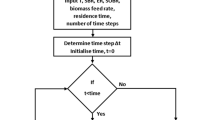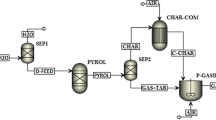Abstract
Gasification is a multiphase process that converts the solid fuels into useful synthetic gas. Despite the potential of biomass gasification as a clean technique to produce a high caloric value syngas, it is not as well looked upon as its advantages suggest. In the present study, an ASPEN plus model of biomass gasification was developed with considering the kinetics of the reactions and tar cracking mechanism. Firstly, the model was validated against the experimental data in the literature. Next, a parametric study was done to investigate and evaluate the performance and produced gas composition of air–steam gasification of biomass. The effect of various operational parameters, such as the reaction temperature, equivalence ratio (ER) and steam/biomass ratio (S/B) on the gas product composition, products yield and the gasifier performance was investigated. The results showed that the increase of reaction temperature not only can enhance the H2 content in the gas stream, but inhibit the formation of tar. The achieved optimal conditions for production of maximum H2 content (16.18 vol %) were as follows: reaction temperature of 800 °C, S/B of 0.8 and ER of 0.211.











Similar content being viewed by others
References
Tauqir W, Zubair M, Nazir S. Parametric analysis of a steady state equilibrium-based biomass gasification model for syngas and biochar production and heat generation. Energy Convers Manag. 2019;199:111954.
Hiloidhari M, Baruah DC, Kumari M, Kumari S, Thakur IS. Prospect and potential of biomass power to mitigate climate change: a case study in India. J Clean Prod. 2019;220:931–44.
Nowicki L, Antecka A, Bedyk T, Stolarek P, Ledakowicz S. The kinetics of gasification of char derived from sewage sludge. J Therm Anal Calorim. 2011;104:693–700.
Strezov V, Moghtaderi B, Lucas JA. Thermal study of decomposition of selected biomass samples. J Therm Anal Calorim. 2003;72:1041–8.
Puig-Gamero M, Argudo-Santamaria J, Valverde JL, Sánchez P, Sanchez-Silva L. Three integrated process simulation using aspen plus®: pine gasification, syngas cleaning and methanol synthesis. Energy Convers Manag. 2018;177:416–27.
Jeong YS, Kim JW, Seo MW, Mun TY, Kim JS. Characteristics of two-stage air gasification of polystyrene with active carbon as a tar removal agent. Energy. 2021;219:119681.
Campoy M, Gómez-Barea A, Villanueva AL, Ollero P. Air–steam gasification of biomass in a fluidized bed under simulated autothermal and adiabatic conditions. Ind Eng Chem Res. 2008;47:5957–65.
Upadhyay DS, Panchal KR, Sakhiya AKV, Patel RN. Air-steam gasification of lignite in a fixed bed gasifier: influence of steam to lignite ratio on performance of downdraft gasifier. Energy. 2020;211:118187.
Yang H, Wang C, Xu S, Liu R. Biomass gasification over hematite in a decoupled dual loop gasifier. Fuel Process Technol. 2019;192:140–6.
Hasler P, Nussbaumer T. Gas cleaning for IC engine applications from fixed bed biomass gasification. Biomass Bioenergy. 1999;16:385–95.
Zhang LH, Xu CB, Champagne P. Overview of recent advances in thermochemical conversion of biomass. Energy Convers Manag. 2010;51:969–82.
Yu J, Smith JD, Golpour H, Alembath A, Al-Rubaye H, Gao X. Validation and application of a kinetic model for downdraft biomass gasification simulation. Chem Eng Technol. 2019. https://doi.org/10.1002/ceat.201900304.
Hejazi B, Grace JR, Bi X, Mahecha-Botero A. Kinetic model of steam gasification of biomass in a bubbling fluidized bed reactor. Energy Fuels. 2017;31:1702–11.
Ostermeier P, Fischer F, Fendt DS, Spliethoff H. Coarse-grained 784 CFD-DEM simulation of biomass gasification in a fluidized bed reactor. Fuel. 2019;55(785):115790.
Miao Q, Zhu J, Barghi S, Wu C, Yin X, Zhou Z. Modeling biomass gasification in circulating fluidized beds. Renew Energy. 2013;50:655–61.
Corella J, Sanz A. Modeling circulating fluidized bed biomass gasifiers: a pseudo–rigorous model for stationary state. Fuel Process Technol. 2005;86:1021–53.
Kallis KX, Pellegrini Susini GA, Oakey JE. A comparison between miscanthus and bioethanol waste pellets and their performance in a downdraft gasifier. Appl Energy. 2013;101:333–40.
Ma Z, Ye J, Zhao C, Zhang Q. Gasification of rice husk in a downdraft gasifier: the effect of equivalence ratio on the gasification performance, properties, and utilization analysis of byproducts of char and tar. Bioresour. 2015;10:2888–902.
Hejazi B, Grace JR, Bi XT, Mahecha-Botero A. Kinetic model of steam gasification of biomass in a dual fluidized bed reactor: comparison with pilot plant experimental results. Energy Fuels. 2017;31:12141–55.
Zhai M, Wang X, Zhang Y, Dong P, Qi G, Huang Y. Characteristics of rice husk tar secondary thermal cracking. Energy. 2015;93:1321–7.
Liu L, Huang Y, Cao J, Liu C, Dong L, Xu L, Zha J. Experimental study of biomass gasification with oxygen-enriched air in fluidized bed gasifier. Sci Total Environ. 2018;626:423–33.
Das B, Bhattacharya A, Datta A. Kinetic modeling of biomass gasification and tar formation in afluidized bed gasifier using equivalent reactor network (ERN). Fuel. 2020;280:118582.
Acknowledgements
This paper is supported by President Fund of Xi'an Technological University (Grand: XAGDXJJ15004) and Shaanxi Key Research and Development Plan (2020GY-147).
Author information
Authors and Affiliations
Corresponding author
Additional information
Publisher's Note
Springer Nature remains neutral with regard to jurisdictional claims in published maps and institutional affiliations.
Rights and permissions
About this article
Cite this article
Fu, L., Cao, Y. & Bai, Y. Development of a comprehensive simulation model for H2-rich syngas production by air–steam gasification of biomass. J Therm Anal Calorim 147, 8069–8075 (2022). https://doi.org/10.1007/s10973-021-11041-5
Received:
Accepted:
Published:
Issue Date:
DOI: https://doi.org/10.1007/s10973-021-11041-5




